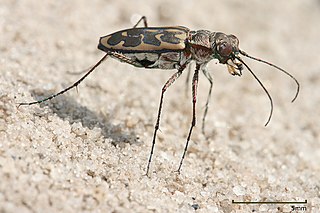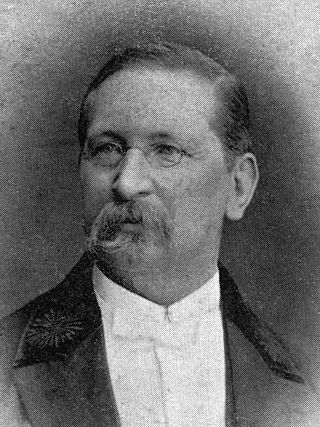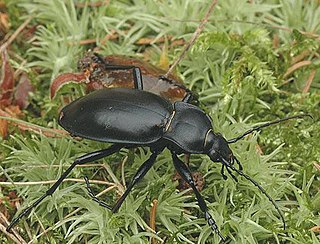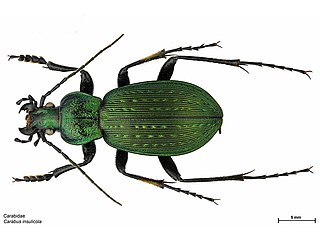
Tiger beetles are a family of beetles, Cicindelidae, known for their aggressive predatory habits and running speed. The fastest known species of tiger beetle, Rivacindela hudsoni, can run at a speed of 9 km/h, or about 125 body lengths per second. As of 2005, about 2,600 species and subspecies were known, with the richest diversity in the Oriental (Indo-Malayan) region, followed by the Neotropics. While historically treated as a subfamily of ground beetles (Carabidae) under the name Cicindelinae, several studies since 2020 indicated that they should be treated as a family, the Cicindelidae, which are a sister group to Carabidae within the Adephaga.

Tord Tamerlan Teodor Thorell was a Swedish arachnologist.

Puccinia recondita is a fungus species and plant pathogen belonging to the order of Pucciniales and family Pucciniaceae.

Carabus is a genus of beetles in family Carabidae. The genus is highly diverse with 94 subgenera, 959 species and 2300 subspecies, thus is the largest genus in the subfamily Carabinae. The vast majority are native to the Palearctic, but 16 Nearctic species are also known. Carabus spp. are 12–50 mm (0.47–1.97 in) long, and most species are wingless and often very colourful. These are nocturnal, predatory beetles that feed on snails, earthworms, and caterpillars. Most Carabus species were thought to have inhabited the Eurasian forest, but the species' low dispersal abilities altered the distribution of lineages within the genus.

Thiamin pyrophosphokinase 1 is an enzyme that in humans is encoded by the TPK1 gene.

Interferon omega-1 is a protein that in humans is encoded by the IFNW1 gene.

Myosin light polypeptide 6 is a protein that in humans is encoded by the MYL6 gene.

Sodium/hydrogen exchanger 5 is a protein that in humans is encoded by the SLC9A5 gene.

Zinc finger protein 267 is a protein that in humans is encoded by the ZNF267 gene.

Carabus smaragdinus is a species of beetle belonging to the family Carabidae.

Calliptamus siciliae, commonly known as the pygmy pincer grasshopper, is a species of short-horned grasshoppers belonging to the family Acrididae subfamily Calliptaminae.

Yersinella raymondii, common name Raymond's bush-cricket, is a species of "katydids crickets" belonging to the family Tettigoniidae subfamily Tettigoniinae. The scientific name Yersinella comes from the name of the entomologist who has described the species in 1860.

Voltage-gated hydrogen channel 1 is a protein that in humans is encoded by the HVCN1 gene.
Haplotrachelus is a genus of beetles in the family Carabidae, containing the following species:
Carabus anatolicus is a species of ground beetle from family Carabidae found on Cyprus and in Near East. The black coloured species can also be found in Turkey.

Carabus insulicola is a species of black-coloured beetle from family Carabidae, that is endemic to Japan. Some of the species can be of green or brown colour.
Kirk J. Fitzhugh is the curator at the Natural History Museum of Los Angeles County, a position he has held since 1990. His research focuses on the systematics of polychaetes and on the philosophical foundations of evolutionary theory. Fitzhugh is a critic of DNA barcoding methods as a technical substitute for systematics. He attends Willi Hennig Society meetings where he has argued that "synapomorphy as evidence does not meet the scientific standard of independence...a particularly serious challenge to phylogenetic systematics, because it denies that the most severely tested and least disconfirmed cladogram can also maximize explanatory power." His graduate supervisor was V. A. Funk, from the U.S. National Herbarium, National Museum of Natural History, Smithsonian Institution MRC. He completed his doctoral thesis on Systematics and phylogeny of Sabellid polychaetes in 1988 while he was a research scientist at the LA County museum He married a lawyer named Nancy E. Gold in 1989.
Josef Wilhelm Klimesch was an Austrian entomologist who specialised in lepidoptera. His collection is housed in the Bavarian State Collection of Zoology, Munich.
Cosmorhaphe is an ichnogenus representing grazing feeding behavior (pascichnia).

Monte Is Caravius is the highest massif in the Sulcis Mountains, in southern Sardinia, Italy. The information on the height of the relief is still under debate: geographical atlases, historical bibliographic sources, and official documentation attribute the height of 1116 m; other sources, including several of an administrative or technical-scientific nature that use information from territorial information systems, indicate a height of 1113 m.













